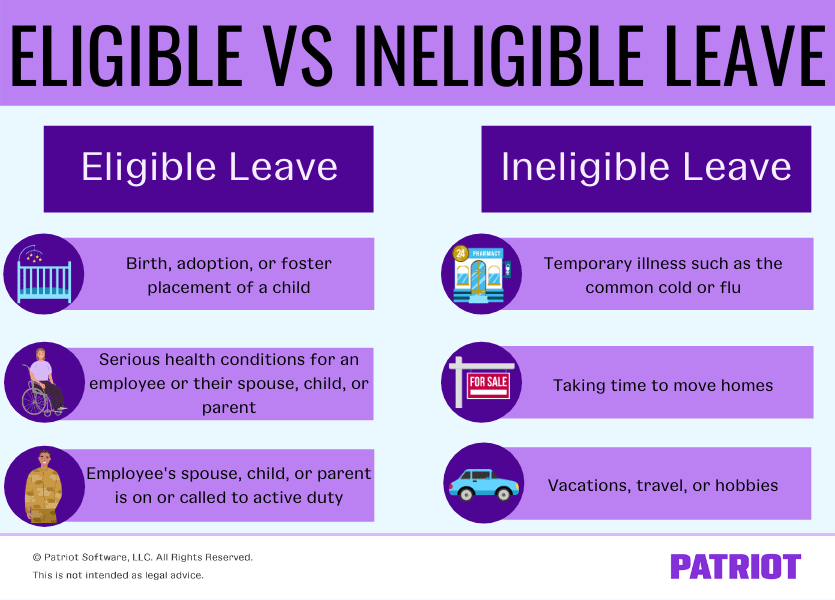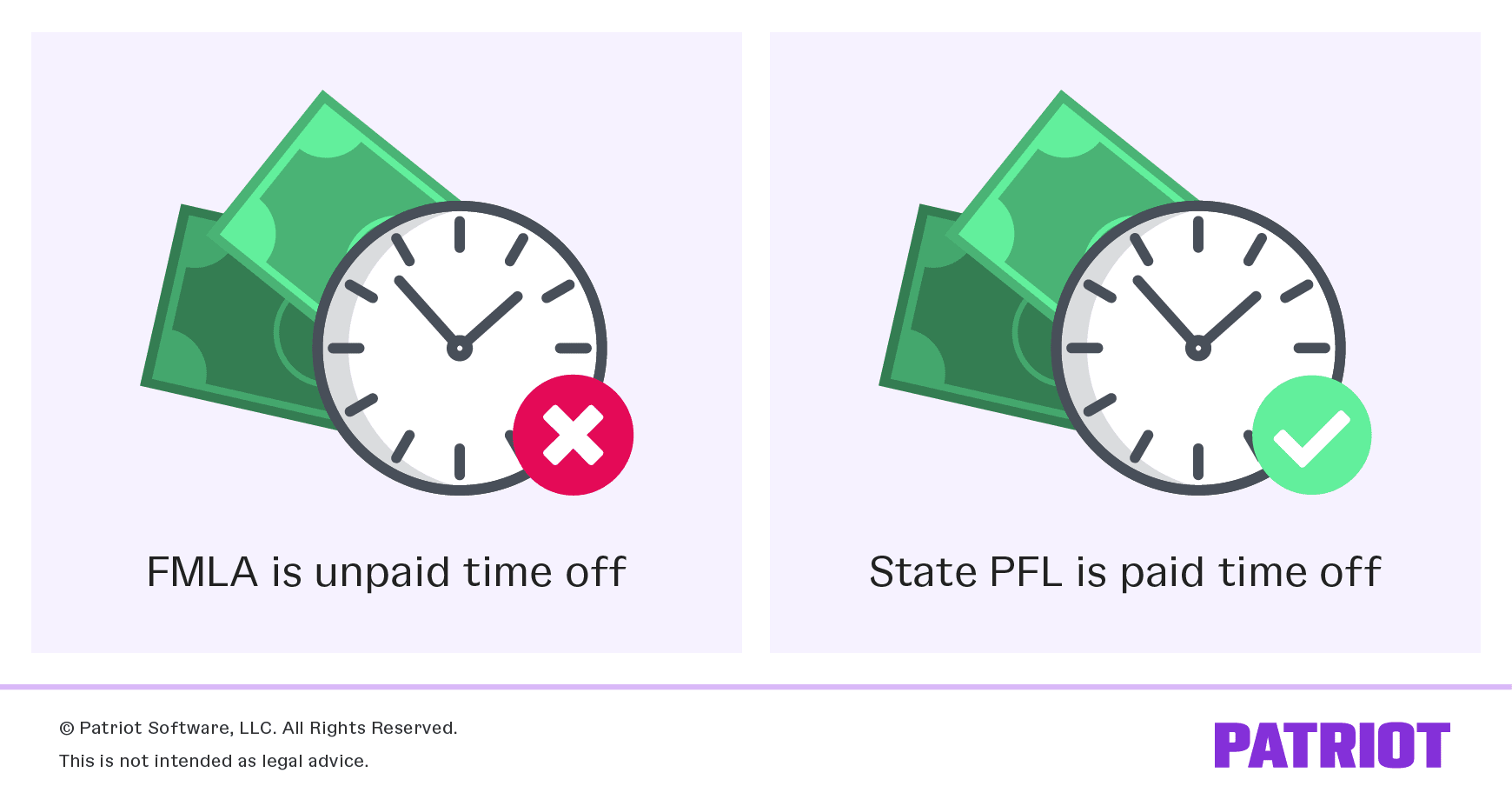As a small business owner, you may have a lot of questions about FMLA, starting with, What is FMLA? To help you better understand FMLA and your roles and responsibilities as an employer, here are the basics of the law, eligibility requirements, and how to remain compliant as an employer.
What is FMLA?
So, what does FMLA mean, and exactly what does FMLA stand for? FMLA, or Family and Medical Leave Act, is a federal law that protects a worker’s job if they need to take time off work for qualifying reasons. Employees are entitled to 12 weeks of unpaid leave each year, and their job is protected until they return.
Family medical leave includes:
- FMLA-covered parental leave, such as the birth of a child, adoption, or foster care placement of a child
- A serious health condition that limits an employee’s ability to perform essential functions of his or her job
- Caring for a child, spouse, or parent who has a serious health condition
- A situation that requires attention because of the military deployment of a spouse, child, or parent. Employees can take up to 26 weeks of unpaid leave during a 12-month period to care for a covered servicemember who is a spouse, child, or parent with a serious injury or illness

FMLA guidelines for employers state that you must continue to pay for the employee’s health benefits even if their leave is unpaid.
How employees can use FMLA
There are two ways that employees may take Family and Medical Leave Act time: continuously or intermittently. Both ways are limited by the same 12 weeks of eligible time in a 12-month period.
Continuous leave
Under the FMLA, continuous leave is when an employee uses the 12 weeks of available time at once. As an employer, you cannot require that your employee use all of their 12 weeks continuously.
Intermittent leave
Employees can use intermittent leave in reduced amounts of time when medically necessary. Under the FMLA, your employee can break up the 12 weeks of leave over the course of the year for a single qualifying reason. Employees can either reduce their daily or weekly work schedule or take FMLA leave in blocks of time.
When using FMLA intermittently, employees must make a reasonable effort to work with you to schedule their leave to avoid disrupting operations unnecessarily. You may temporarily transfer the employee to an alternative role within the company with equivalent pay and benefits to accommodate the intermittent leave.
Intermittent leave is used in certain circumstances, such as medical therapy or treatment that cannot be performed outside of work hours. You can grant intermittent leaves in certain cases when the employee or their parent, child, or spouse is seriously ill. You may also agree to an intermittent leave plan for the birth of a child.
When do employees become eligible for FMLA benefits?
Employees can use FMLA leave if they:
- Work for a covered employer
- Have worked 1,250 hours during the 12 months before the time of leave
- Work at a location where the employer has 50 or more employees within 75 miles; and
- Have worked for the employer for 12 months. These 12 months do not have to be consecutive.
Both full- and part-time employees have FMLA eligibility and the right to use leave if they meet these requirements.
Tracking FMLA leave
Per the FMLA rules, you have four options for tracking the leave your employees take in a defined 12-month period. You can:
- Use the 12-month period between January 1 and December 31
- Use a fixed 12-month period such as your company’s fiscal year, the 12-month period beginning with the employee’s anniversary date, or a 12-month period defined by state law
- Begin the 12 months with the start date of the employee’s first day of FMLA leave
- Count backward 12 months from the date the employee most recently used FMLA leave to calculate a rolling leave. Then, count how much leave the employee used in that 12-month period to determine the amount of leave the employee has left
Reference the U.S. Department of Labor (DOL) Fact Sheet #28H to learn more about calculating the 12-month period. Read more about tracking an employee’s leave usage on DOL Fact Sheet #28I. Employees who want to learn how to apply for FMLA can view additional FMLA forms on the DOL website.
Which businesses must offer FMLA leave?
You may be asking yourself, Does FMLA apply to small businesses? In short, the Family and Medical Leave Act applies to businesses that meet certain criteria, so you might be required to give leave to your employees.
If your business has more than 50 employees in a 75-mile radius, you must offer the FMLA. This includes public, private, and nonprofit businesses.
Keep in mind is that your business does not need to have 50 employees at the time an employee requests FMLA leave. Instead, this number means that you must have had 50 employees in 20 or more workweeks in the current or previous calendar year to be considered a covered employer under FMLA requirements.
FMLA: Small business
Some (but not all) small businesses with fewer than 50 employees must offer FMLA to their employees.
Integrated and joint employers
Even if your business has fewer than 50 employees, you might need to offer FMLA leave if you are considered an integrated employer or a joint employer.
Integrated employers typically own multiple branches or locations of their business. You might be an integrated employer if you have two or more businesses with:
- Common management
- Interrelated operations
- Centralized control of labor relations
- A degree of common ownership or financial control
Joint employers typically use an employee sharing or leasing service, otherwise known as contract staffing. Under FMLA guidelines, you might be a joint employer if:
- You and another employer share an employee’s services or interchange employees
- One employer acts in the interest of another employer in relation to an employee
- You and another employer share control of an employee because one employer controls, is controlled by, or is under common control with the other employer
If you are a joint employer or an integrated employer, count the employees from all locations. If the combined number of employees is 50 or more, you must offer FMLA leave.
Let’s say you manage three restaurants, each with 20 employees within 75 miles. If you are considered an integrated employer, count the total number of employees at all the restaurants. Since there are 60 total employees (3 restaurants X 20 employees), you must offer FMLA leave to your employees.
Family and Medical Leave Act vs. paid family and medical leave
Now that you know the basics of the FMLA, you may be asking yourself about paid family and medical leave (PFML). There are states with paid family leave programs that give paid time off to employees for qualifying reasons. These state programs are separate from the federal FMLA program.
Some differences between FMLA and PFML include:
- Whether the time off is paid or unpaid
- How much time you must offer to employees
- When employees qualify for leave
- The number of employees needed to qualify
Check with your state to review your state’s laws requiring Paid Family and Medical Leave.
FMLA vs. PFML vs. FFCRA
Throwing another wrench into the Family and Medical Leave Act confusion was the introduction of the Families First Coronavirus Response Act (FFCRA) in 2020. This law is separate from the other types of leave.
FFCRA sick leave is for COVID-19-related time off from work. The law required private employers with fewer than 500 employees to offer paid sick leave between April 1, 2020 – December 31, 2020. As of January 1, 2021, the leave is optional for employers. The current FFCRA expires on March 31, 2021.
Tracking time off for your employees does not have to be time-consuming. Patriot payroll seamlessly integrates with our online time and attendance add-on to help you keep track. Try it today with a free trial.
This article has been updated from its original publication date of April 3, 2012.
This is not intended as legal advice; for more information, please click here.


